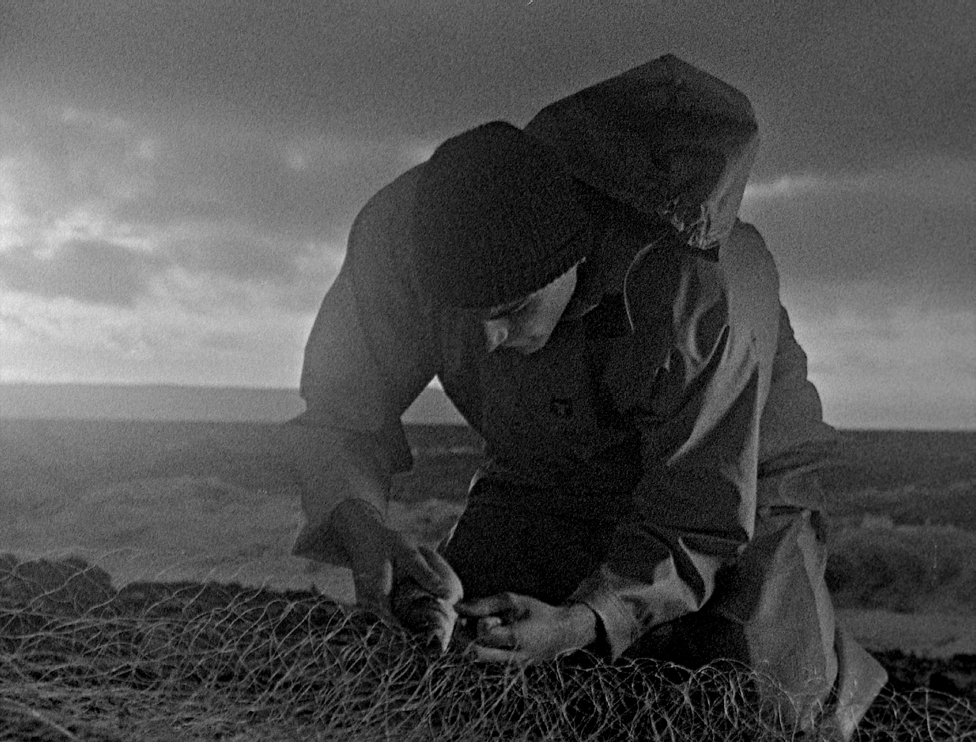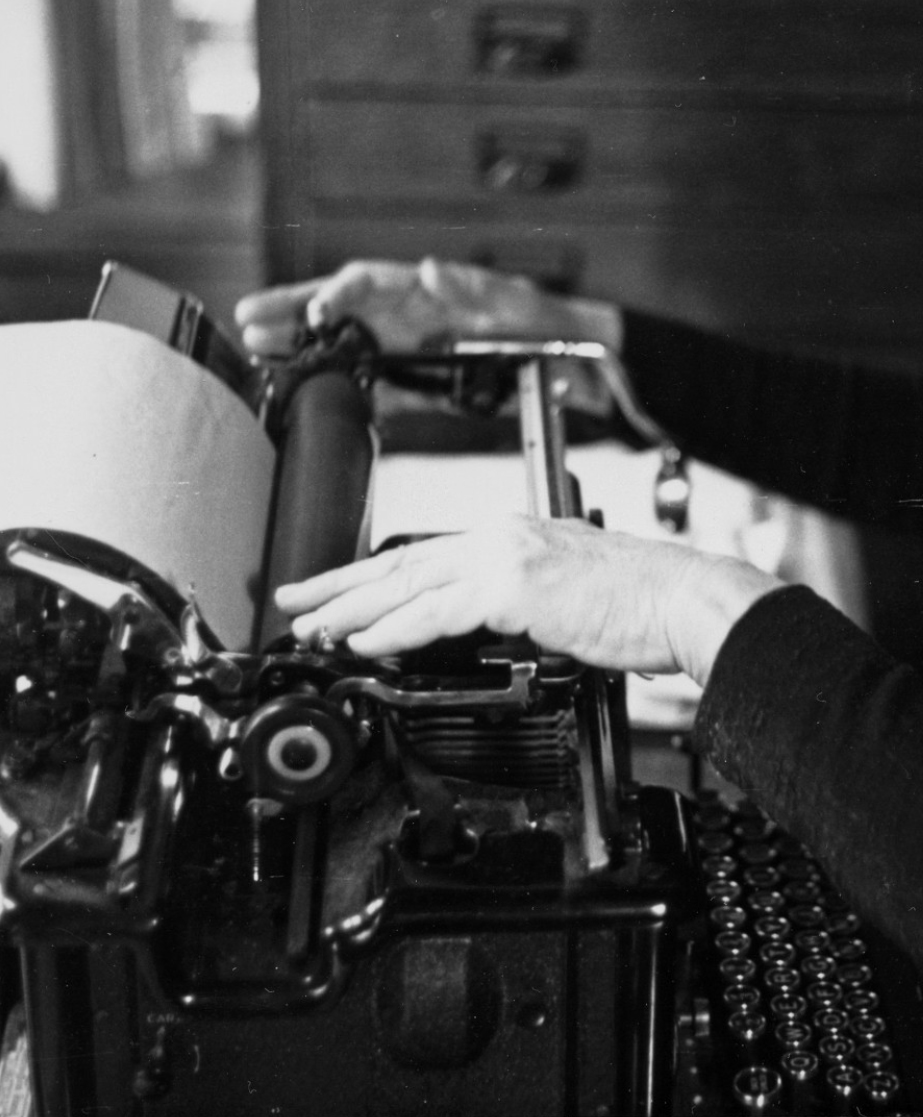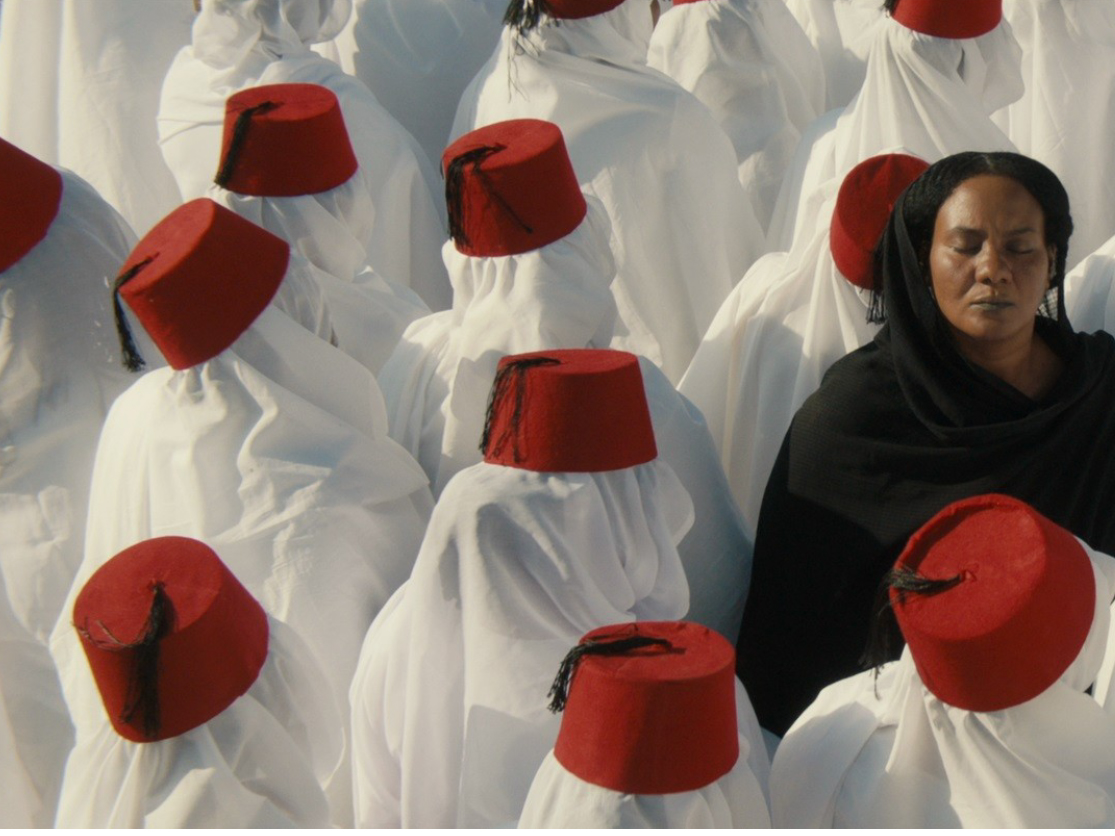White River Indie Films, familiarly known as WRIF, is based in White River Junction, Vermont, where D.W. Griffith shot major portions of his 1920 melodrama Way Down East. Its annual festival focuses on issue-oriented films, some of them produced in its own part of the country, others in distant lands. Ancillary activities include a partnership with public-access television, a Regional Showcase for local filmmakers, and a contest encouraging teens to explore aspects of local culture. WRIF presented its first festival the year after it was founded in 2004 and initiated year-round programs in 2015. In 2020 it navigated the Covid-19 pandemic with virtual screenings and events during its usual spring timeslot, a Race and Elections series in the autumn, and a winter show punningly called the Light River Junction Festival of Cinema, projecting works on building facades, outdoor screens, and snowbanks.
The 2021 event was another hybrid, filling ten days in May with online films, in-person outdoor screenings, and an evening Zoom Lounge for informal chatting. The lineup was diverse in all respects, comprising ten features, about a dozen shorts, and assorted panels and discussions. The festival was keen to point out that a majority of its selections were directed by women and minority filmmakers, with categories ranging from LGBTQIA and BIPOC/Latinx to World Cinema and Artistic Innovations. As these groupings indicate, the program was globally representative and aesthetically adventurous.
Opening-night attractions can send useful signals about a festival’s priorities and overall quality, and Jennifer Maytorena Taylor’s documentary For the Love of Rutland was a felicitous kick-off movie for WRIF 2021, coming from the festival’s own region yet conveying insights applicable to anyplace beset by poverty, addiction, inadequate housing, unreliable health care, and xenophobia. The film anatomizes almost three years in the life of working-class Rutland, Vermont, focusing on two representative figures: Stacie Griffin, a single mother and recovering addict coping with personal and household travails, and Chris Louras, the local mayor, whose down-to-earth idealism is challenged by the town’s fierce divisions over welcoming Syrian refugees as new residents. The nonfiction narrative evolves in interesting and unexpected ways, as Griffin becomes increasingly involved in community improvement, Louras gets voted out of office – a development he greets with unabashed ill will – and the Trump Administration’s infamous Muslim ban renders the refugee question moot, delighting some residents and dismaying others. The civic love expressed by For the Love of Rutland is tough love, charged with clear-eyed compassion.
Although no single theme unified the WRIF program, For the Love of Rutland was one of several films offering culturally sensitive portraits of communities. Another was Bait, a British picture written and directed by Mark Jenkin, which has won the BAFTA award for outstanding debut by a British filmmaker. Its reputation is entirely deserved. Set in a fishing village on the Cornish coast, the drama centers on a man named Martin Ward (Edward Rowe) who catches fish and lobsters for a living but finds himself without a boat when his more ambitious brother Steven (Giles King) starts using their jointly owned vessel for tourist excursions. Adding more friction, their family’s house is now occupied by owners from outside, who have smoothed away its hardscrabble authenticity in favor of tackiness and kitsch. The intersecting class, economic, and professional conflicts of the adult characters are echoed by skirmishes among the younger ones, where romantic factors also play a part. Bait is etched on grainy 16mm stock that Jenkin processed by hand, giving it a ragged, down-market look that suits the low-rent narrative to perfection. But its purposefully primitive surfaces notwithstanding, this is a work of top-level cinematic sophistication, with montage sequences recalling Robert Bresson, textures worthy of Jack Smith, and sound-image counterpoints that Sergei Eisenstein could have applauded. This extraordinary artwork was a WRIF highlight, supplemented by a Vermont-oriented panel discussion of gentrification, tourism, and class conflict. Jenkin’s distinctive style is also evident in the darkly poetic Hard, Cracked the Wind, one of the festival’s most memorable shorts.
The threatened traditionalism depicted in Bait seems relatively stable and reliable when contrasted with the Istanbul captured in Stray, the first full-length documentary by Elizabeth Lo, who named the film after two types of stray – homeless dogs and young Syrian refugees –scraping a meager existence on the city’s margins. Lo keeps her cameras at dog’s-eye level (or dog’s-nose level) through most of the film, giving a tactile sense of what life is like when streets, sidewalks, building sites, and gutters are the places you call home. Although the film’s amiable dogs face ongoing dangers from careless drivers and canines less peaceable than themselves, they are protected from captivity and euthanasia by current Turkish law, and they may have better prospects than the kids, who survive by begging and amuse themselves by sniffing glue. Lo portrays their perilous circumstances objectively, suggesting her own views through intertitles bearing philosophical quotations. Although more commentary might have deepened and strengthened the film, it makes an engaging companion piece to Kedi, a 2016 documentary by Turkish director Ceyda Torun that does for cats what Stray does for dogs. Doctoral dissertations will surely be written about the recurring combination of free-ranging animals, low-slung cameras, and Istanbul.
A very different community emerges in Estou Me Guardando Para Quando O Carnaval Chegar/Waiting for the Carnival, the first documentary by Marcelo Gomes, one of today’s most prominent Brazilian directors. Here we discover the little town of Toritama, whose name means “land of happiness” in the Tupi language, although “land of hard-won contentment” more accurately describes the village as it now exists. As a child, Gomes visited there with his tax-collector father, and as an adult he is amazed at how drastically the place has changed. It now proclaims itself The Capital of Jeans, the manufacture of which is almost every resident’s vocation. Nobody works in an industrial plant or factory, since the great bulk of production is done in “factions,” small workshops where laborers take manifest pride in turning out large amounts of product, pocketing wages commensurate with their efforts, and answering to no bosses but themselves. The movie’s title, taken from a pop song of the 1970s, points to one of the motivations that keep Toritama humming cheerfully along: anticipation of the annual carnival, to which everyone flocks for eight days of seaside amusement. Yet while the workers seem pleased with their business and financial arrangements, the approach of carnival brings out a fundamental weakness. Many citizens are unwilling or unable to save up for the yearly excursion, which they fund with hasty sales of personal possessions, from TV sets to sewing machines, and since the latter are indispensable tools of their trade, they must be repurchased when folks are back in town for another 51 weeks of work. Gomes never explains the mechanics of this wobbly economic system, and no one in Toritama seems very concerned about it, preferring to focus on comforting routines of the present rather than bothersome complications of the future. Waiting for the Carnival is not a deep film but it is highly picturesque, photographed in widescreen splendor and edited with gently shifting rhythms that suit the town’s trademark mixture of longterm industriousness and shortterm indolence. It also presents a number of efficiently crafted personality sketches, making a nonconformist goatherd and a super-casual young slacker into figures who stand pleasingly out from the crowd.
A more experimental South American film, Ficción privada/Private Fiction, returns the Argentine filmmaker Andrés Di Tella to territory he has visited before, probing family memories represented by a variety of artifacts and mementos. The offbeat documentary begins with photographs held by an unseen person walking through a series of environments, establishing thematic contrasts – past and present, stasis and movement, presence and absence – that Di Tella then elaborates with specific family histories evoked by home-movie footage, clips from earlier films, dialogues between his daughter and himself, and readings by actors from letters written by his parents, a mixed-race couple (Latinx man, Indian woman) who raised many a conservative eyebrow in the 1950s. Introspective and understated, Private Fiction is bravely personal cinema.
Another offbeat documentary, Her Socialist Smile, comes from John Gianvito, a Boston-based filmmaker specializing in politically alert cinema with a leftwing perspective. His new film is an unusually structured biopic about the deafblind author, speaker, and disability-rights activist Helen Keller, whose resilience and charisma have overshadowed the broader dimensions of her political activities, which included outspoken commitments to women’s suffrage, workers’ rights, and radical socialism. Matching his style to his subject, Gianvito presents lengthy passages from Keller’s writing as printed texts on an otherwise black screen, a device that annoys some spectators but makes Keller’s profound relationship with written words (mostly braille for her) a palpable presence in the film, which also includes archival photos, bits of popular and classical music, quoted dialogue from a vaudeville act that Keller participated in, part of a 1989 lecture by the linguist and activist Noam Chomsky, and intermittent narration by the poet and human-rights advocate Carolyn Forché, who is seen occasionally at her microphone. Gianvito knows the merits of quiet, indirect forms of cinematic persuasion – most of his 2007 short Profit Motive and the Whispering Wind is an extended montage of words printed on monuments, markers, and memorials dedicated to progressive elements in American history – and Her Socialist Smile is a marvelous example of how effective his method can be. In a WRIF Zoom discussion I conducted, Gianvito noted that the Keller archive was largely destroyed in a New York City fire sparked by the 9/11 attacks, and that he took the resulting paucity of audiovisual materials as a creative challenge, finding other ways of bringing her cinematically alive. He has succeeded splendidly.
No region of the world is more underserved by mainstream distributors than Africa, the source of two notably exciting WRIF selections. Eyimofe/This Is My Desire, which hails from Nigeria’s astoundingly prolific film industry, has more than enough risk-taking elements to contradict notions that Nollywood is wedded exclusively to low-budget commercial production. Directed by the twin brothers Arie and Chuko Esiri, it tells two separate but related stories with conspicuously European titles – “Spain” and “Italy” – that name the countries to which the main characters dream of moving until sudden crises spring up and confound their conscientiously made plans. The first story centers on Mofe (Jude Akuwudike), a factory technician and security guard living with his sister and her young children. He has most of his emigration money in hand and is such an enthusiast for Spain that he gives his name as Sanchez on his passport application. But disaster strikes when his three housemates die in a mishap with a household generator, and it strikes again when he finds that his finances will be drained by funeral expenses and a court battle over the family’s meager estate. The film’s second half centers on Rosa (Temiloluwa Ami-Williams), a bartender and hairdresser with a pregnant teenage sister, Grace (Cynthia Ebijie), under her care. Rosa has made a distressing bargain with Mama Esther (Chioma Omeruah), a grasping entrepreneur willing to fund her emigration in exchange for possession of Grace’s baby when it is born. The baby is lost in another manner, however, pitching Rosa’s emigration hopes into the same sad condition as her relationship with her touchy landlord (Toyin Oshinaike) and her fleeting romance with an American expatriate (Jacob Alexander) whose higher socioeconomic status proves problematic. The filmmakers convey the pathos of these tales with the restraint found in fine neorealist cinema.
The festival’s other African attraction, You Will Die at 20, is a Sudanese-French-Egyptian-German-Norwegian-Qatari coproduction, but far from being an international pudding, it is deeply rooted in Sudan, where it was filmed. It lives up to its ominous title from the beginning, when a mother named Sakina (Islam Mubarak) seeks a blessing on her newborn child, Muzamil, only to be told by a mystic that the child’s life will end within two decades. The boy (Moatasem Rashed, then Mustafa Shehata) grows into an admirable youth despite his overprotective mother and absent father, memorizing the Quran twice over, finding work with a local bootlegger, and learning about cinema from a village cynic with experience of the wider world. But his achievements and adventures are shadowed by the prophecy of his early death. Raising timeless questions about predestination and free will, spirituality and materiality, and mortality and the purpose of life, You Will Die at 20 has been called an existentialist folktale and a coming-of-death story. The absorbing drama with pronounced philosophical overtones foretells a bright future for first-time filmmaker Amjab Abu Alala.
No entry in WRIF 2021 was more timely than There Is a Field, an American blend of drama and documentary that records a theater performance directed by Heather Holmes, filmed by writer-director Jen Marlowe, and fleshed out with archival and news footage related to two parallel subjects. One is the fight for Palestinian rights, embodied here by the death of Asel Asleh, a 17-year-old Palestinian, at the hands of Israeli police during a demonstration in 2000. The other is the struggle against American police violence and white supremacy being waged by Black Lives Matter and likeminded activist movements. Marlowe and Asleh were friends, and There Is a Field grew from her belief that the similarities between Palestinian and Black American victimization extend “not just to the issue of police brutality” but also to comprehensive problems of “impunity and structural racism.”1 The title comes from a poem by the Persian visionary Rumi, quoted several times in the film: “Out beyond ideas of wrongdoing and rightdoing, / there is a field. I’ll meet you there.”2 Before being filmed, the play was developed in an extensive series of residencies and performances; the movie has a deliberately roughhewn quality, with performers reading from the script and making little show of professional polish. Its strongest asset is a deep-dyed sincerity that bespeaks the firm connection of the actors with their highly charged material. There Is a Field is unvarnished political drama with a potent international agenda, and its urgency was underscored by headlines about Israeli-Palestinian strife and American gun violence that appeared with grim frequency as WRIF 2021 was unfolding.
Young people are also the focus of Dramarama, a teen comedy that would seem altogether fluffy if not for its underlying concern with problems of gender identity and inclusion. The story was inspired by writer-director Jonathan Wysocki’s memories of his own adolescence, which explains the film’s warmly affectionate tone and nostalgic nods to 1990s pop culture. This is very much an ensemble movie, giving many characters approximately equal weight as they gather for a whimsical roleplaying party before heading off to college. The most interesting of them is Gene (Nick Pugliese), who has realized his gay identity, wants to come out, but can’t quite find the courage, which is understandable, since the viewpoints of his friends are shaped in part by the conservative Christian school they’ve all attended. Dramarama contains enough droll episodes and subplots to keep Gene’s particular dilemma from taking over the movie, but his quandary lends focus and seriousness to an otherwise lightweight entertainment.
Along with its stimulating full-length films, WRIF 2021 served up a similar number of well-chosen shorts. Among the most outstanding were David Lynch’s The Rabbit Hunters (USA), a characteristically surrealistic romp; Quinn Thomashow’s Nature’s Optical Toy (USA), inspired by the venerable phenakistoscope and recalling the avant-garde virtuosity of Stan Brakhage; Rainer Kohlberger’s It Has to Be Lived Once and Dreamed Twice (Austria/Germany), a science-fiction extravaganza; Sebastián Pizón Silva’s Palenque (Colombia), a tribute to Latin American history; and Mina Fitzpatrick’s Wandervogel (USA), a paradoxically poetic account of events tied to murder and obsession. The short-film slate was a salutary reminder that excellent cinema has no upper or lower time limits, and the festival as a whole demonstrated that TV and computer monitors can convey the power of resourcefully made movies as rousingly as the large theatrical screens that are their natural habitat in normal, pandemic-free times.
Author Biography:
David Sterritt, editor in chief of Quarterly Review of Film and Video and past chair of the New York Film Critics Circle and the National Society of Film Critics, served for years on the New York Film Festival selection committee and has been on festival juries in Moscow, Vienna, San Francisco, Toronto, Tribeca, and beyond.
Notes
- Michael Arria, “‘There’s been profound shifts in the world’s willingness to grapple with these questions’: Jen Marlowe’s new film aims to connect movements and struggles,” Mondoweiss (26 October 2020) https://mondoweiss.net/2020/10/theres-been-profound-shifts-in-the-worlds-willingness-to-grapple-with-these-questions-jen-marlowes-new-film-aims-to-connect-movements-and-struggles/. Accessed May 27, 2021. ⮭
- Rumi, “Out Beyond Ideas,” trans. Coleman Barks. Poetry Chaikhana, http://www.poetry-chaikhana.com/Poets/R/RumiMevlanaJ/Outbeyondide/index.html. Accessed May 27, 2021. ⮭







